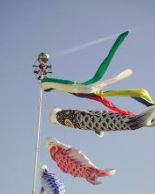|

|
Every May 5, it is Kodomo no Hi or "Children’s Day" in Japan. Families fly koinobori banners in the shape of a carp for each child in their house. In Japanese folklore, the carp is a symbol of determination and vigor, overcoming all obstacles to swim upstream. Bows and arrows, Japanese swords, samurai warrior figurines, dolls depicting boys in armor riding fine white horses, and samurai kabuto helmets are also displayed in homes to inspire strength and bravery.
According to the Kodansha Encyclopedia of Japan, the festival was first celebrated in Japan in 839 and at that time it was called Tango no Sekku or Shoubu no Sekku. Sekku is the Japanese word for "iris" which blooms when the festival is held. The leaves of the iris plant resemble swords and as such the celebration was dedicated to boys.
|
The carp banners, or kites, are attached to a long bamboo pole and there is one kite for each child in the family. The first kite on the bamboo staff, usually a large black one, represents the father. A smaller red kite just below that one represents the mother, while even smaller ones below the mother represent the kids. The number of kites on a staff may actually not accurately represent the number of children in the family and in these modern times the colors may not follow that traditional order. Some families with only one child, for example, may fly more carp banners on their staff in hopes of adding more children in the future.
Children's Day is the final celebration of what is known as Golden Week, a springtime vacation and recreation festival celebrated throughout Okinawa - and all of Japan. Children's Day was established by the Japanese government in 1948. Before World War II, the celebration was called "Boys' Day".
Children indulge in kashiwa-mochi, sticky rice cakes wrapped in oak leaves, and other sweets. Around the islands there are many events for children and families. Children take center stage in traditional Japanese plays. Thousands of children compete in the "Kids' Olympics" held at the National Kasumigaoka Stadium in Tokyo. Children also use the day to thank and show respect for the teachers, parents, and relatives who care for them.
Until 1948, the day of May 5 was called Tango no sekku and only honored boys. A separate holiday called Hinamatsuri or "Dolls' Day" celebrated girls on March 3. Even now, on this day girls still receive dolls that had been passed down to/from their grandmothers and mothers. For many families, May 5 still centers on boys. Some people say that Hinamatsuri for girls should become an equal holiday instead of combining them into one.
| |
Create Your Own Koinobori
Materials:
24" x 18" piece of fabric or heavy paper.
fabric paint, paintbrush, markers, and colored tissue paper
glue
ribbon
stapler
strip of thin cardboard (about 17 inches in length and between ˝-1" wide)
hole puncher
string (about 16 inches in length)
Instructions:
1. Fold the fabric in half lengthwise (so it is 24" x 9").
2. Draw a fish with an opening for the mouth and tail (at least 6 inches wide at each end). The body should be about 12 inches at the widest.
3. Cut along your lines so you have two identical fish shapes.
4. Using paint, markers, glue and tissue paper, decorate both fish.
5. Wait until dry. If using fabric, lay one decorated fish face-up on a table. Lay the other piece decoration-down on top of it. (The two decorated sides will be touching each other.) Smear glue along the sides of the fish, creating a ˝ seam. (Leave the mouth and tail with no glue so the wind can blow through.) When glue is dry, turn your koinobori right side out.
6. If using paper: lay first fish face-down on table and smear glue along edges, leaving mouth and tail with no glue so wind can blow through. Place other fish on top of first, face-up and press down along seams.
7. Glue pieces of ribbon to the end of the tail.
8. Fit the piece of cardboard around the inside rim of the koinobori mouth.
9. Staple the ends together so it forms a circle.
10. Push the cardboard circle about an inch inside the mouth and secure with glue. Fold the inch or so of excess fabric or paper over and glue to the inside rim.
11. Using the holepunch, make a hole on either side of the fish mouth. Cut a piece of string or ribbon about 16 inches long. Tie each end of the string to the holes.
12. Hang your koinobori outside and watch it swim in the breeze!
Sources:
asiasociety.org (Heather Clydesdale)
This Week on Okinawa, May 2-9, 1990
|


